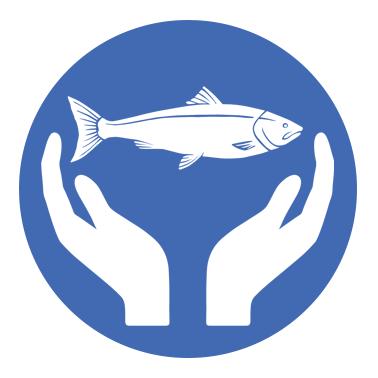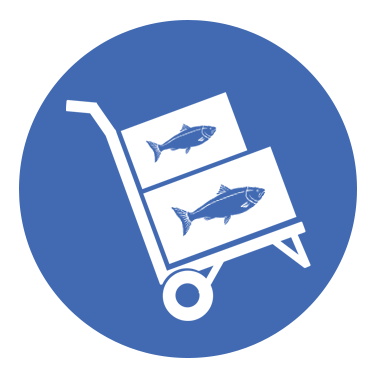You’ve likely heard all the buzz words about fish; wild, premium, sustainable, organic, healthy, natural, ethical, and antibiotic free, but what do they actually mean to you, the consumer? Some don’t mean much because the qualities referenced are unregulated, and the terms can be printed on any label. Our fish meets and exceeds the criteria for all those buzz words, though I’m going to talk about the three that matter most to us and our family: wild, sustainable, and healthy. I’ll add one of my own buzzwords as well –delicious!
Wild: Why does it matter? There’s a lot going on right now in the world of fish farming and it’s often hard to tell what new name marketers have created to fool you into believing you are getting a fish that actually lived a life without human intervention. Wild caught Alaska salmon and whitefish varieties mature at a natural pace and swim freely in the pristine waters off Alaska’s rugged 34,000-mile coastline, eating only what nature provides. That coastline is a clean environment, protected by more than forty Marine Protected Areas (MPAs), covering hundreds of thousands of square miles established to safeguard this sensitive habitat from human activity. These cold, clean waters of Alaska are home to the world’s finest seafood.
Sustainable: Sustainable seafood is managed and fished using practices that ensure there will always be more to catch in the future. The secret to
Alaska’s sustainability success relies on two basic principles:
Responsible fisheries management and sustainable fishing practices take care not to harm the fish, other marine plants and animals, nor the environment.
Responsible fisheries do not allow overfishing. Overfishing happens when so many fish are taken from the sea that there are not enough left to replenish the natural population. (Alaska Seafood and Sustainability In Plain English)
Alaska is second to none when it comes to protecting marine life. In fact, no Alaska seafood has ever been listed as endangered under the Endangered Species Act.
For more information on sustainability, see the “Sustainability In Plain English brochure” at http://www.alaskaseafood.org/sustainability/resources/
Healthy: If you are looking for a meal that is nutritious, low in saturated fat, and high in the “good fats” — heart-healthy omega-3s, you’ve come to the right place.
Wild Alaskan seafood is naturally high in many essential vitamins. It contains vitamins A, C, and D. Some varieties are also very high in antioxidant E, which has proven to strengthen the immune system, and lower the risk of heart disease by reducing the buildup of plaque in coronary arteries. Some studies also reveal possible protection against cancer and the formation of cataracts.
In addition, the health benefits of long-chain omega-3 fatty acids that are found exclusively in fish and shellfish are now well known. The body has a strong preference for these seafood-based acids versus the omega-3s found in plants, such as walnuts or flax. It is important to know the difference to make smart choices for your health.
Alaskan seafood also contains a wide variety of minerals including zinc, iron, calcium, and selenium. http://www.alaskaseafood.org/health-nutrition/
Delicious: The superior flavor and texture of Alaska seafood is prized around the world. The delectable flavor and vibrant color comes from the fish feeding on their natural diet of marine organisms. The firm texture of halibut and salmon and the velvety texture of black cod come from annual migrations in the cold North Pacific.
These superior qualities stand out easily with most any simple cooking method. Whether you like to grill, poach, bake, or sauté, you can have delicious fish on the table in minutes. You don’t have to be a chef to make an amazing meal that will impress your family or guests and leave you feeling like you just had a five-star restaurant meal. Growing up in the Midwest, the occasional walleye or northern pike was about the only fish I had any experience cooking. My first summer on a purse seiner, I cooked plenty of salmon and halibut for the first time and it always turned out delicious. The three species of fish we offer are surprisingly forgiving to even the most novice chef. My only advice would be to try not to overcook it, but I’ve forgotten salmon on the BBQ many times, leaving it burnt to a crisp on the edges and my guests still raved about the taste. Some, including my son and myself, even enjoy the crispiness. I’ve also overcooked black cod tips in the oven many times and they are still delicious. I firmly believe that it would take a lot of negligence to ruin black cod because of the oil content. It just won’t dry out. Check out our recipe page for some of our favorite recipes and tips and you’ll be cooking fish like you’re a gourmet chef.
Frozen vs. Fresh:
One question I’m often asked is how to buy fresh seafood. The better question to ask is – how do I buy the best quality fish? One of the easiest ways to ensure you are getting the highest quality fish for your family is often to buy it frozen. I’ve heard the stories of buying fish from a fish counter and having it taste horrible. Was it sitting there thawing for too long? Was it mishandled by the employees? Was it mixed up or switched with a lower grade of fish and you didn’t actually get what you paid for? The closest thing to catching it yourself or buying it off a boat that just came into port, is to buy it fresh frozen. If you are intimidated by or dread your grocer’s seafood counter, don’t give up on seafood all together, just find a frozen source. Seafood quality cannot be improved once it leaves the water, it can only be maintained. Seafood needs to be frozen quickly to prevent cellular damage. Our fish is rapidly chilled down as soon as it comes out of the water, then vacuum packed, sealing air out to help preserve flavor, flesh color, nutritional value, and superb texture. Flash freezing then results in a product that tastes as good as the day it left the water. One of the best reasons we’ve found to buy frozen fish in bulk is that when it is in our freezer, we eat more of it. We know it is good for our health, and by having it readily available – we are committing to eating well.
Frozen fish thaws quickly, but if you’re running short on time, you can cook it frozen. Visit http://www.wildalaskaseafood.com/slideshow/cook-it-frozen/ for tips and recipes showing how to cook your fish without thawing.












